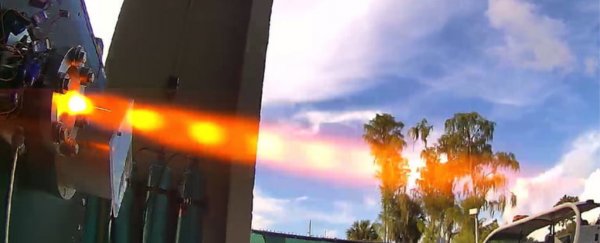A type of rocket engine once thought impossible has just been fired up in the lab. Engineers have built and successfully tested what is known as a rotating detonation engine, which generates thrust via a self-sustaining wave of detonations that travel around a circular channel.
As this engine requires far less fuel than the combustion engines currently used to power rockets, it could eventually mean a more efficient and much lighter means of getting our ships into space.
"The study presents, for the first time, experimental evidence of a safe and functioning hydrogen and oxygen propellant detonation in a rotating detonation rocket engine," said aerospace engineer Kareem Ahmed of the University of Central Florida.
The idea of the rotating detonation engine goes back to the 1950s. It consists of a ring-shaped - annular - thrust chamber created by two cylinders of different diameters stacked inside one another, creating a gap in between.
Gas fuel and oxidiser are then injected into this chamber through small holes and ignited. This creates the first detonation, which produces a supersonic shockwave that bounces around the chamber. That shockwave ignites the next detonation, which ignites the next, and so forth, producing an ongoing supersonic shockwave to generate thrust.
This should produce more energy for less fuel compared to combustion, which is why the US Military is investigating and funding it; this new research was funded by the US Air Force, and it's not the only such project the military are looking into.
In practice, however, there's a reason rockets are generally powered by internal combustion instead, in which the fuel and oxidiser are mixed to produce a slower, controlled reaction to generate thrust.
Detonation is chaotic and much harder to control. In order for the whole thing to not blow up - very literally - in your face, everything needs to be precisely calibrated.
The fuel used, the oxidiser ratio, the size of the holes, the size of the annular chamber, the size and shape of the reactor, when and where the fuel is injected - these all need to be considered, and change in relation to each other. For example, different types of fuel could require injection holes of different size or shape.
This fine-tuning is what Ahmed and his team have been working on. They created a careful balance of the hydrogen and oxygen, and tried it out on their test engine, a small, 7.6-centimetre (3-inch) rotating detonation rocket engine modelled after one designed by the US Air Force Research Laboratory.
"We have to tune the sizes of the jets releasing the propellants to enhance the mixing for a local hydrogen-oxygen mixture," Ahmed explained.
"So, when the rotating explosion comes by for this fresh mixture, it's still sustained. Because if you have your composition mixture slightly off, it will tend to deflagrate, or burn slowly instead of detonating."
 (Sosa et al., Combustion and Flame, 2020)
(Sosa et al., Combustion and Flame, 2020)
To show that the rig worked, the team also injected a methane tracer into the hydrogen, and used a high-speed camera to capture the detonation waves. Their images, they say, show continuous five-wave co-rotating detonations moving in a counter-clockwise direction.
If it can be scaled up, this technology could significantly lighten rocket payloads, and reduce the costs of rocket launches, but it has other potential applications, too. In 2012, the US Navy predicted that rotating detonation engines could result in a 25 percent reduction in fuel use in its ships, and shave 300-400 million of its annual US$2 billion fuel bill.
"These research results already are having repercussions across the international research community," said William Hargus of the Air Force Research Laboratory's Rotating Detonation Rocket Engine Program.
"Several projects are now re-examining hydrogen detonation combustion within rotating detonation rocket engines because of these results. I am very proud to be associated with this high-quality research."
The research has been published in Combustion and Flame.
